Monuments in Brazil reflect the country’s diverse architectural history and cultural evolution across centuries. Located in South America, home to structures spanning colonial, modernist, and futuristic styles. These monuments attract global attention for their design, cultural relevance, and historical context. The country’s urban centres, like Rio de Janeiro, Brasília, and São Paulo, preserve these architectural icons. Visitors can explore religious structures, civic buildings, and cultural centres. Brazil’s monuments highlight its political heritage, scientific progress, and artistic expression.
Top 10 Monuments In Brazil To Visit
Explore these monuments in Brazil, including religious icons, contemporary structures, and institutions that reflect scientific, political achievements and cultural significance.
1. Christ The Redeemer
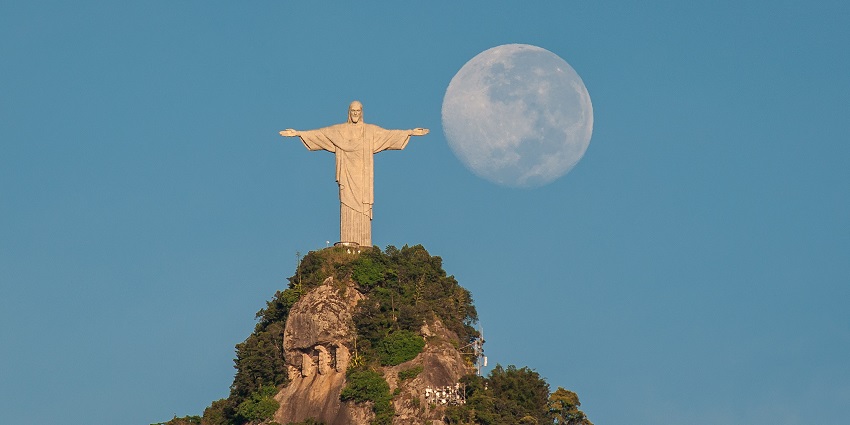
Photo: Donatas Dabravolskas / Wikimedia Commons
Standing atop Corcovado Mountain in Rio de Janeiro, Christ the Redeemer is one of the most famous monuments in Brazil. This 98-foot-tall statue, made of soapstone and concrete, was inaugurated in 1931. Designed by engineer Heitor da Silva Costa, it symbolises peace and Christian faith while reflecting Brazil’s 20th-century engineering progress. You can enjoy a scenic ride through Tijuca Forest on the Corcovado Rack Railway. The statue’s arms-outstretched design draws tourists and pilgrims alike, serving as a national emblem.
Major Attractions: Corcovado Rack Railway, Tijuca National Park
Timings: 8 AM to 6 PM
Entry Fee: R$ 79 / ₹1182.17
Location: Rio de Janeiro, State of Rio de Janeiro
2. Sugarloaf Mountain
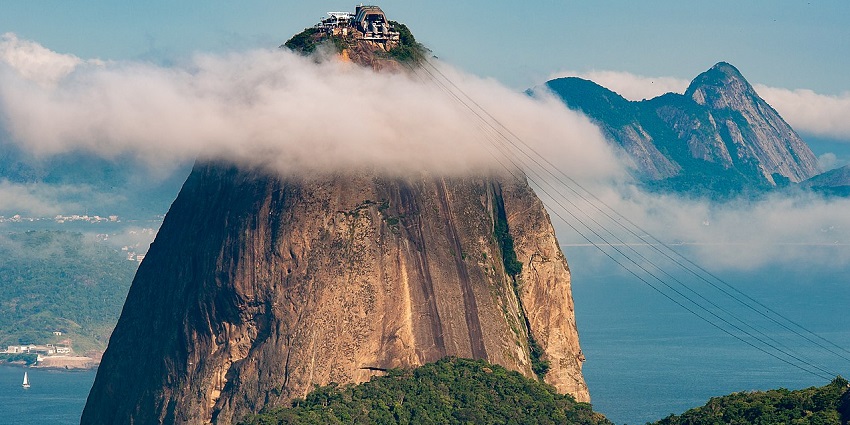
Photo: Donatas Dabravolskas / Wikimedia Commons
Sugarloaf Mountain, at the mouth of Guanabara Bay, is a natural granite peak accessed by cable cars. Rising 396 meters above sea level, its glass-walled cabins offer views of Rio de Janeiro’s coastline and nearby landmarks. The mountain’s location once supported early colonial defences, making it historically significant. Today, it functions as a key sightseeing point with observation decks. Visitors often pair it with nearby Urca Hill for an extended visit, combining natural formation with urban exploration and viewing opportunities.
Major Attractions: Cable car rides, Urca Hill Station
Timings: 8.30 AM – 7 PM
Entry Fee: R$ 135 / ₹2020
Location: Rio de Janeiro, State of Rio de Janeiro
3. Cathedral Of Brasília
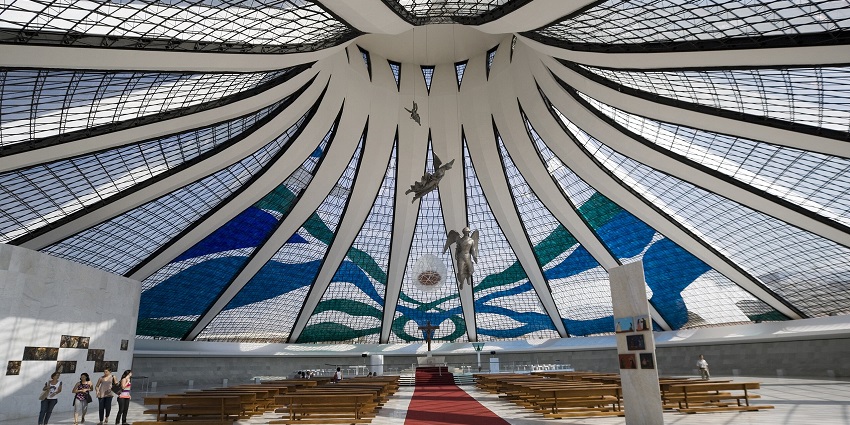
Photo: Dasfour2022 / Wikimedia Commons
As one of the most popular monuments in Brazil, the Cathedral of Brasília merges architectural ingenuity with spiritual intent. Completed in 1970 by Oscar Niemeyer, the cathedral features 16 curved columns forming a crown-like structure. Access is through an underground walkway, giving a surprising upward view. Inside, stained glass by Marianne Peretti filters natural light over suspended angel sculptures. The design draws attention to Brazil’s modernist architectural identity. Visitors often reflect on its use of light and space during their visit to the capital.
Major Attractions: Stained glass ceiling, sculptures by Dante Croce
Timings: 8 AM – 6 PM
Entry Fee: Free
Location: Brasília, Federal District
4. Teatro Amazonas
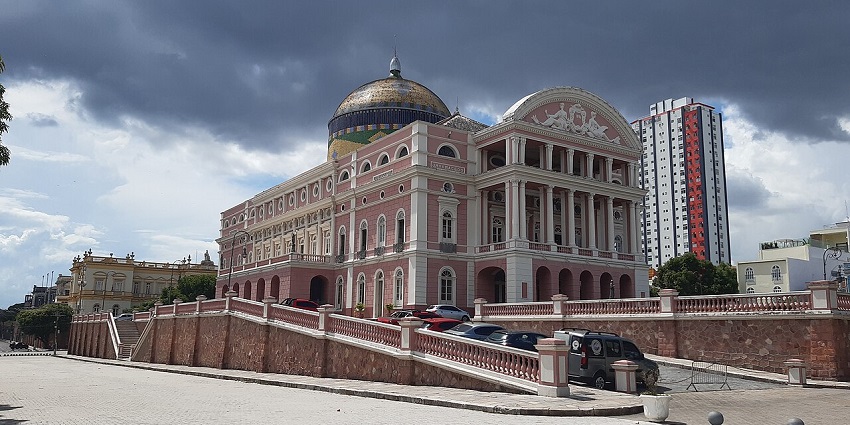
Photo: Ridiculopathy / Wikimedia Commons
Teatro Amazonas, located in Manaus, reflects the economic boom from Brazil’s rubber trade in the late 19th century. This opera house blends imported European materials with Brazilian artistry. The dome’s colourful ceramic tiles match Brazil’s flag, highlighting national pride. Inside, guests find velvet seating, chandeliers, and stage areas suited for world-class performances. Tours and concerts allow visitors to connect with Manaus’ cultural history. Its location in the Amazon adds a contrasting backdrop, tying together regional trade, global art, and architectural ambition, making it one of the best monuments in Brazil.
Major Attractions: Guided tours, opera performances
Timings: 9 AM – 5 PM
Entry Fee: R$ 10 / ₹149.64
Location: Manaus, State of Amazonas
5. Museum Of Tomorrow
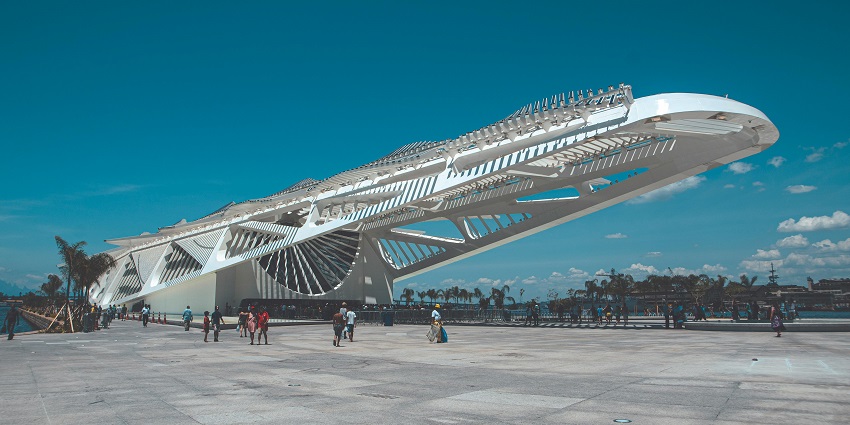
Photo: Bruno Scramagnon / Pexels
The Museum of Tomorrow stands beside Pier Mauá and draws visitors interested in global issues and technological change. Designed by Santiago Calatrava, its architecture reflects scientific themes, with solar panels and energy-efficient systems embedded in the structure. Inside, interactive exhibits address climate, biodiversity, and future trends. The museum plays a dual role in presenting knowledge through engaging visuals and promoting awareness about human impact. Visitors leave with a greater understanding of science, ethics, and collective futures. Hence, it is one of the best monuments in Brazil.
Major Attractions: Interactive science exhibits, rotating exhibitions
Timings: 10 AM – 6 PM (closed on Mondays)
Entry Fee: R$ 30 / ₹450
Location: Rio de Janeiro, State of Rio de Janeiro
6. São Paulo Cathedral
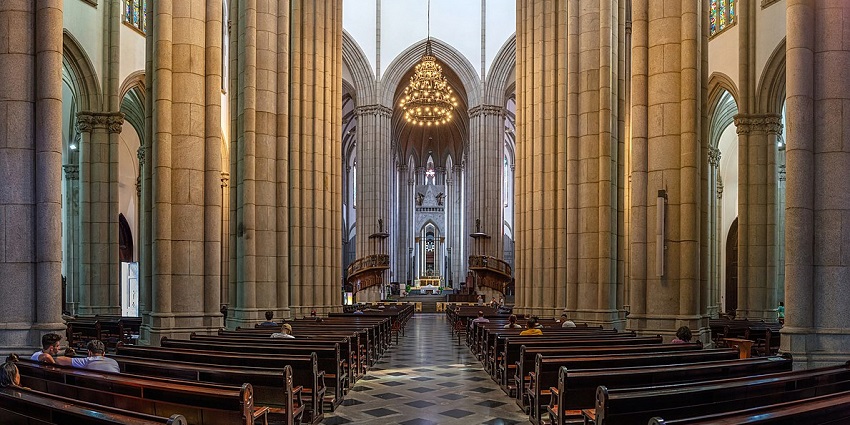
Photo: Wilfredo Rafael Rodriguez Hernandez / Wikimedia Commons
As one of the major monuments in Brazil, São Paulo Cathedral balances architectural grandeur with religious importance. Built in Neo-Gothic style and completed in 1954, it includes a Renaissance-style dome and stained glass windows. The cathedral is often used for public ceremonies and religious gatherings. Located at Praça da Sé, it marks São Paulo’s historical and geographical centre. Visitors appreciate its symmetry, craftsmanship, and cultural relevance. The underground crypt contains the remains of historical figures, adding another layer of significance to the structure.
Major Attractions: Crypt, historical stained glass, pipe organ
Timings: 8 AM – 5 PM
Entry Fee: R$ 10 / ₹149.64
Location: São Paulo, State of São Paulo
7. Niterói Contemporary Art Museum
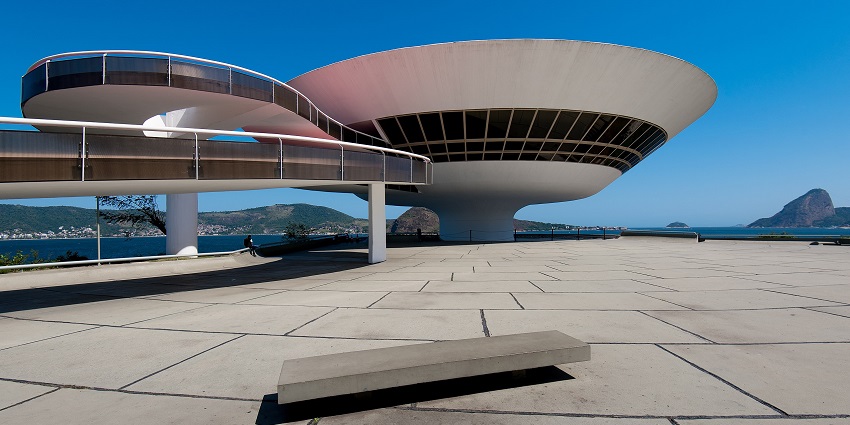
Photo: Donatas Dabravolskas / Wikimedia Commons
The Niterói Contemporary Art Museum offers a forward-looking perspective on Brazilian art. Completed in 1996 by Oscar Niemeyer, its disc-like form is supported by a single pillar and reflects architectural creativity. Overlooking Guanabara Bay, the museum houses rotating exhibitions and features a winding access ramp. Inside, modern and contemporary works from Brazilian artists are on display. The structure stands as both a gallery and a sculptural statement. Many visit not only for the exhibits but also for its thoughtful integration of design and purpose.
Major Attractions: Contemporary art exhibitions, architecture tours
Timings: 10 AM – 6 PM (closed on Mondays)
Entry Fee: R$ 12 / ₹180
Location: Niterói, State of Rio de Janeiro
8. Itamaraty Palace
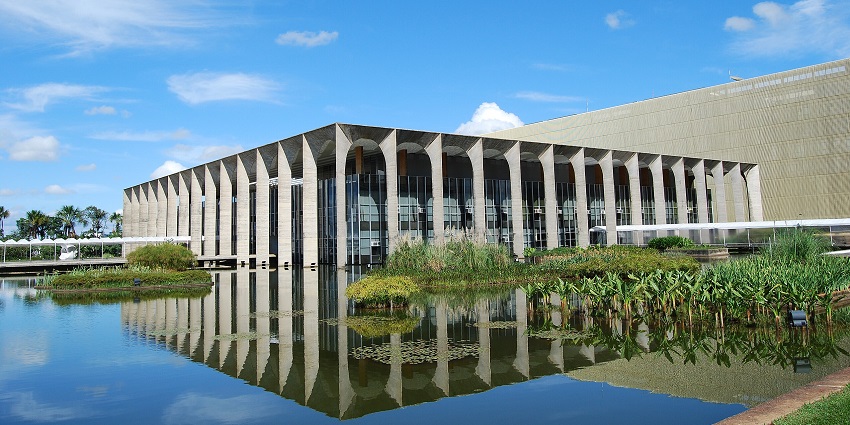
Photo: A C Moraes / Wikimedia Commons
Itamaraty Palace in Brasília acts as a government building and a cultural site. Completed in 1970 by Oscar Niemeyer, it features curved arches and open halls. Visitors can explore artworks by Brazilian masters and finely crafted interiors used for diplomatic events. The building is a central venue for Brazil’s international relations. Its guided tours introduce people to the architecture, decor, and Brazil’s political presence. Surrounded by reflecting water and sculpted gardens, the palace maintains its function while serving as a symbol of governance.
Major Attractions: Diplomatic rooms, artworks by Brazilian masters
Timings: 2.30 PM – 4.30 PM
Entry Fee: Free
Location: Brasília, Federal District
9. Lacerda Elevator
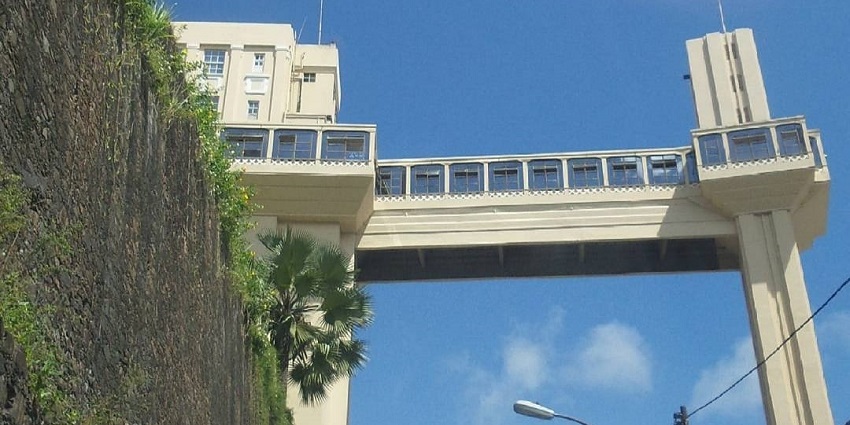
Photo: Milena Cintra / Wikimedia Commons
The Lacerda Elevator connects Salvador’s upper and lower zones and supports residents and tourists. Opened in 1873, the structure was upgraded in 1930 to include twin towers and modern lifts. Over time, it became essential for navigating the city’s steep geography. The elevator runs continuously throughout the day, linking busy commercial centres and historic districts. From its upper platform, visitors get expansive views of All Saints Bay and nearby markets. Its continued use speaks to thoughtful urban design and enduring public utility.
Major Attractions: Bay views, quick transit between city levels
Timings: 7 AM – 10 PM
Entry Fee: R$ 0.15 / ₹2.24
Location: Salvador, State of Bahia
10. Altino Arantes Building
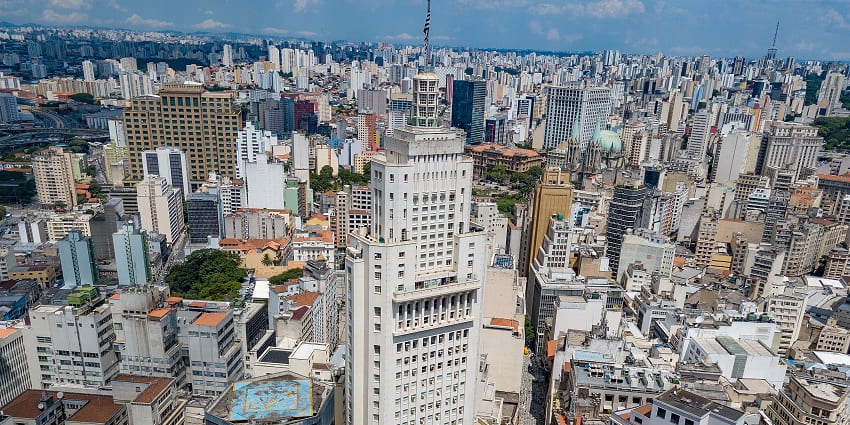
Photo: Webysther Nunes / Wikimedia Commons
Recognised as one of the best monuments in Brazil, the Altino Arantes Building in São Paulo was once Latin America’s tallest structure. Built in 1947 and inspired by New York’s skyscrapers, it signified Brazil’s growing economic power. Today, its observation decks offer far-reaching views, and museum spaces recount São Paulo’s history. Renovated to include event halls and cafés, it attracts those interested in architecture and heritage. The building also stands as a marker of post-war ambition and continues to function as a public venue.
Major Attractions: Viewing deck, São Paulo history exhibitions
Timings: 9 AM – 5 PM (closed on Mondays)
Entry Fee: R$ 20 / ₹300
Location: São Paulo, State of São Paulo
Monuments in Brazil reflect the nation’s artistic ingenuity, religious influences, and political changes through different centuries. These structures appeal to travellers seeking knowledge about Brazil’s origins and evolution through built heritage. From grand churches and forts to modern commemorative sites, perfect for cultural enthusiasts, historians, and curious explorers. Discover such packages offered by TripXL, which ensure each stop contributes to a deeper understanding of the country’s architectural and cultural fabric.
Cover Photo: Paul R. Burley / Wikimedia Commons


 WhatsApp
WhatsApp
 Twitter
Twitter









